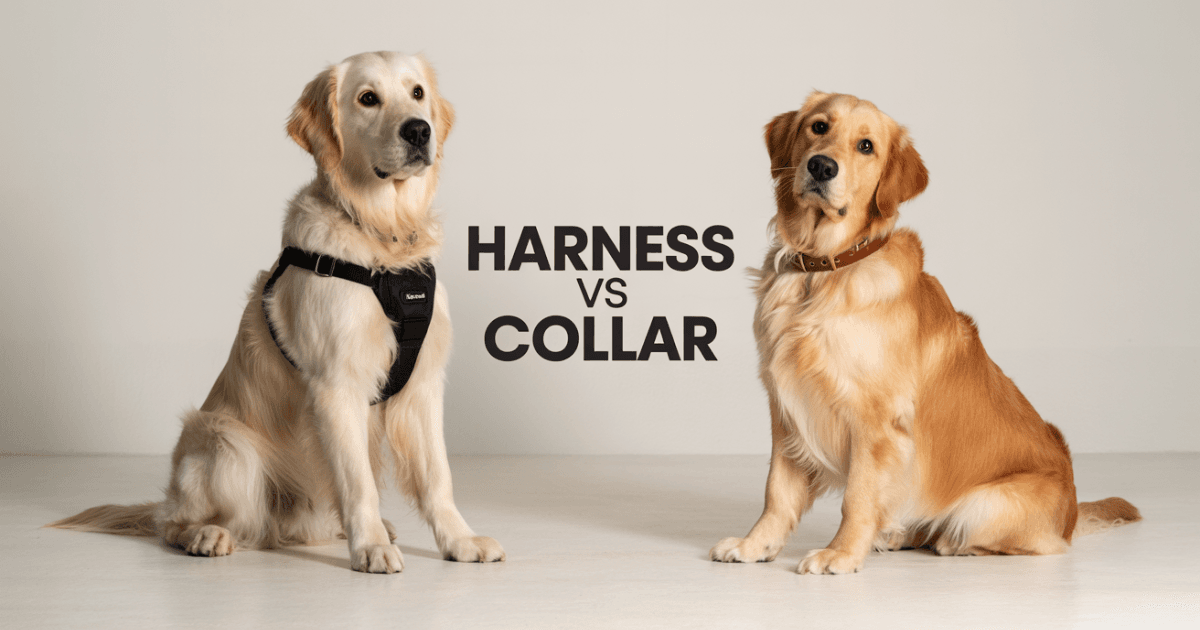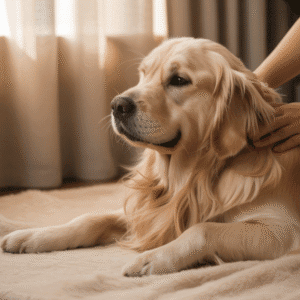
When choosing between a dog harness vs. collar, many pet owners feel confused about which option works best for their furry friend. Collars are great for holding ID tags and work well for calm dogs who don’t pull on walks.
However, harnesses spread pressure across your dog’s chest instead of putting all the force on their neck, making them safer for dogs who tug or have breathing problems. The dog harness vs. collar debate often comes down to your dog’s size, behavior, and health needs. Small dogs usually do better with harnesses because their necks are more fragile, while well-trained larger dogs might be fine with a collar.
Did you know the wrong gear can harm your pet? A pro dog trainer says harnesses are safer than collars. This is because collars can harm your pet’s health.
Choosing between a harness and a collar can be tough. But knowing the difference is key for good training and keeping your pet safe.
Picking the right gear is vital for your pet’s health. A pro dog trainer suggests using a harness. This helps avoid health problems linked to collars.
Key Takeaways
- Using a harness can reduce health risks associated with collar use.
- Harnesses provide better control during walks.
- Collars can cause neck strain and injury.
- Choosing the right equipment is crucial for effective training.
- A harness is a safer option for pets that pull on the leash.
Understanding the Basics of Dog Walking Equipment
It’s important to know about dog walking equipment to care for your pet well. Harnesses and collars are the main tools for walking dogs. Each has its benefits and features.
What Are Dog Harnesses?
Dog harnesses spread the leash’s force across your dog’s chest and shoulders. This is good for dogs that pull hard on the leash.
Types of Harnesses Available
There are many dog harnesses, like step-in and vest-style. Step-in harnesses are easy to put on and take off. Vest-style harnesses offer more support and have more adjustments for a better fit.
Common Materials and Designs
Dog harnesses are made from materials like nylon, polyester, and mesh. The choice depends on the dog’s size, breed, and where they walk.
What Are Dog Collars?
Dog collars are a common piece of walking gear. They come in many styles and are used for walking, training, and identification.
Variety of Collar Styles
There are many collar types, like flat and martingale collars. Flat collars are simple. Martingale collars tighten a bit when a dog pulls, so they don’t slip out.
Traditional vs. Modern Collar Options
Traditional collars are still popular, but modern ones have extra features. These include GPS tracking and reflective materials for safety.
| Equipment | Key Features | Benefits |
|---|---|---|
| Dog Harnesses | Distributes force across chest and shoulders | Reduces strain on neck, ideal for pullers |
| Dog Collars | Simple, traditional design; various styles | Easy to use, suitable for identification and training |
Dog Harness vs. Collar Training Safety: A Comprehensive Comparison

It’s key to know the differences between dog harnesses and collars for safe training. When picking the right gear for your dog, think about design, function, and safety. Each option has its own set of features.
Physical Design Differences
Dog harnesses and collars look very different. A harness goes around your dog’s chest and back. On the other hand, a collar goes around the neck. This big difference changes how each works during training.
Pressure Distribution Comparison
How each distributes pressure is a big safety factor. Harnesses spread the force over the chest and shoulders. This reduces pressure on any one spot. Collars, though, put all the force on the neck. This can cause discomfort or harm, mainly for dogs that pull a lot.
Control and Restraint Capabilities
Harnesses are better at controlling and restraining dogs, mainly those that pull a lot. They spread the force across the body, giving trainers better control. This makes walks and training easier. Many harnesses also have special attachments to stop pulling.
Thinking about these points helps you choose the best gear for your dog’s training. It’s all about their safety and comfort.
The Benefits of Using a Dog Harness

Choosing between a harness and a collar is more than a preference. It’s about keeping your dog safe and helping with training. A dog harness can make walks better for you and your pet.
Reduced Neck Strain and Injury Prevention
Using a dog harness can help prevent neck injuries. Unlike collars, harnesses spread the force across the chest and shoulders. This is great for dogs that pull hard on the leash. It makes walks safer for them.
Better Control for Strong Pullers
Harnesses are better for controlling dogs that pull a lot. They distribute force evenly, making it easier to guide your dog. This is very helpful during training.
Escape Prevention Features
Many dog harnesses have features to prevent escape. They have secure buckles and adjustable straps. These help keep your dog safe during walks. A well-fitted harness can be a lifesaver, for dogs that move suddenly.
| Benefits | Description |
|---|---|
| Reduced Neck Strain | Distributes force across chest and shoulders |
| Better Control | Easier to guide strong pullers |
| Escape Prevention | Secure buckles and adjustable straps |
Advantages of Traditional Dog Collars
Dog harnesses are popular, but traditional dog collars have their benefits. They are simple, effective, and versatile. This makes them a key part of dog training and identification.
Simplicity and Convenience
Traditional dog collars are easy to use. They are simple to put on and take off. When choosing a collar, think about the material, size, and how it adjusts.
ID Tag Placement
Dog collars make it easy to show your dog’s ID tags. This is important for finding your dog if they get lost. Always ensure the ID tags are securely attached to the collar to prevent them from falling off during walks.
Training Applications
Collars are also good for training. They work well with leashes for leash training. They can also hold training tags or other aids. When deciding between a collar vs harness for dogs, think about your dog’s training needs.
Safety Considerations: When to Choose a Harness Over a Collar

Choosing between a dog harness and a collar depends on several safety factors. You need to think about your dog’s breed, health, and activities. This helps decide what’s best for them.
Breed-Specific Concerns
Some dog breeds do better with harnesses because of their body type. For example, brachycephalic breeds and small breeds often have breathing problems. Harnesses are safer for them.
Brachycephalic Breeds
Brachycephalic breeds, like Pugs and Bulldogs, have short noses. This can make breathing hard. A harness spreads out the leash’s pull, not choking their neck.

Toy and Small Breeds
Toy and small breeds are at risk of neck injuries because of their size. Harnesses help by reducing neck strain.
Health Conditions That Warrant Harness Use
Dogs with certain health issues should wear harnesses. Conditions like tracheal collapse and neck and spine issues need harnesses to avoid making things worse.
Tracheal Collapse Risk
Dogs at risk of tracheal collapse should wear harnesses. This is because harnesses don’t put extra pressure on their trachea. Small breeds often face this issue, making harnesses a good choice for them.
Neck and Spine Issues
For dogs with neck or spine problems, harnesses are safer. They don’t add extra strain to these sensitive areas.
Activity-Based Safety Recommendations
The activities you do with your dog also matter. For energetic activities or walks, harnesses offer better control and safety.
By thinking about these points, you can choose what’s safest and most comfortable for your dog.
Training Effectiveness: Comparing Harnesses and Collars

Choosing between a harness and a collar can greatly affect dog training. The right tool can significantly improve leash training and behavior.
Leash Training Results
Harnesses are better for leash training. They spread the leash’s force across the dog’s chest and shoulders. This helps with better leash manners and less pulling. Dogs trained with harnesses pull less and walk better beside their owners.
Behavior Modification Capabilities
Both harnesses and collars can help with behavior training. Harnesses are great for dogs that pull a lot. They offer better control without hurting the dog’s neck. Many professional trainers suggest using harnesses for this reason.
Professional Trainer Recommendations
Professional dog trainers often choose between harnesses and collars. For positive training, harnesses are often preferred. They allow for comfortable, stress-free walks. For correction training, some use collars, but it’s important to do so gently and humanely.
Positive Reinforcement Training
In positive reinforcement training, rewards are given for good behavior. Harnesses are ideal for this because they’re comfortable and safe. They prevent neck injuries.
Correction-Based Training
In correction training, collars might be used, but with care. Avoid harsh corrections that could hurt the dog or ruin training. Trainers should consider the dog’s personality and adjust their methods.
Best Harnesses for Small Dogs: Features and Recommendations
Finding the right harness for small dogs can greatly improve their walks. It’s important to consider sizing, style, and features that make them comfortable and mobile.
Sizing and Fit Considerations
Getting the right fit is key for small dogs to avoid discomfort and health problems. Measure your dog’s girth to pick a harness that fits well but not too tight. Adjustable straps are essential for a good fit as your dog grows or changes.
Top Harness Styles for Small Breeds
Small dog owners often like step-in or vest-style harnesses. These are easy to use and comfortable.
Step-In Harnesses
Step-in harnesses are easy to put on, as your dog steps into them. They’re great for dogs that don’t like having their heads or necks touched. Look for ones with padded chest plates for extra comfort.
Vest-Style Harnesses
Vest-style harnesses offer full-body support and a secure fit. They spread the leash’s force across the chest and back, easing neck strain. Many have reflective strips for better visibility during walks.
Comfort and Mobility Features
When choosing a harness, think about comfort and mobility. Look for padded straps, breathable materials, and ergonomic designs. Make sure the harness lets your dog move freely without causing discomfort.
Essential Dog Training Gear Beyond Harnesses and Collars
Effective dog training needs more than just a harness or collar. These are key for walking and basic control. But, more gear can boost your training sessions.
Training Leads and Leashes
Training leads and leashes are crucial for control during training. Choose durable, comfy ones that fit your style. Retractable leashes offer flexibility, while fixed-length ones are consistent.
Treat Pouches and Reward Systems
Treat pouches are handy for trainers, making rewards easy to access. A good reward system uses treats, praise, and affection. It’s essential for positive reinforcement training.
Training Aids and Clickers
Tools like clickers mark good behaviours, helping your dog understand what you want. They’re great for precise timing and clear training.
Dog Walking Safety: Best Practices for Every Owner
Dog walking safety is about the right gear, knowing your surroundings, and being ready for emergencies. As a dog owner, it’s key to know these to keep walks safe and fun for you and your dog.
Proper Equipment Fitting and Adjustment
Ensuring your dog’s gear fits right is vital for safety. Ill-fitting harnesses or collars can cause discomfort, injury, or even let your dog escape.
The Two-Finger Rule
The two-finger rule is a helpful guide. You should be able to fit two fingers between the gear and your dog’s skin. This means the gear is snug but not too tight.
Signs of Poor Fit
Watch for signs of a bad fit, like rubbing, chafing, or trouble breathing. If you see these, adjust the gear or try a different size or style.
Weather and Environmental Considerations
Weather and the environment can affect dog walking safety. Extreme temperatures, rain, or snow can be risky for your dog. Always check the weather before walking and plan your route.
Emergency Preparedness During Walks
Being ready for emergencies is essential. Carry a basic first-aid kit, have a plan for emergencies, and make sure your dog’s ID is current.
By following these tips, you can make dog walks safer and more enjoyable for your dog.
Pet Accessories Comparison: What Works Best with Harnesses vs. Collars
Choosing the right gear for dog walks is key. It’s important to think about how accessories fit with your choice of harness or collar.
Leash Types and Compatibility
The leash you pick can change your walk. Harnesses go well with standard or retractable leashes for control. Collars need a quick-release leash for safety. Make sure the leash is tough and easy to hold.
ID and GPS Tracking Options
ID tags are a must for both harnesses and collars. Collars have them right on, making them easy to see. Harnesses might need a special holder or a separate ID tag. GPS tracking devices work with both, adding safety for curious dogs.
Reflective and Visibility Features
Reflective and visibility features are crucial at night. Harnesses and collars with reflective strips or LED lights help your dog be seen. Adding reflective leashes or lights can make walks safer.
Thinking about these points helps you pick the best gear. This way, walks can be fun and safe for you and your dog.
🐶 Want Better Control — Harness or Collar Won’t Matter If Your Dog Won’t Listen!
Train Your Dog to Walk Calmly — No Pulling, No Barking, No Stress.
👉 Discover Adrienne Farricelli’s Brain Training for Dogs – a fun, science-backed program trusted by thousands of dog parents!
💡 What You’ll Love:
✅ Designed by a certified dog trainer (CPDT-KA)
✅ Fixes leash pulling, barking, anxiety & more
✅ Step-by-step videos for dogs of all breeds and ages
✅ Gentle, reward-based training (no harsh methods!)
✅ Lifetime access – train at home, at your pace
🎯 Whether you’re using a collar or harness – training is the REAL game-changer.
👉 Start Brain Training for Your Dog Today »
Conclusion: Making the Right Choice for Your Dog
Choosing between a dog harness and a collar depends on your dog’s needs. Consider their health, breed, and training needs. The right choice affects their safety and happiness during walks and training.
Dogs that pull a lot or have breathing problems do better with a harness. It spreads the force across their chest and shoulders. This helps avoid neck injuries and strain.
For small dogs, picking the right harness is key. Look for ones that are comfy and safe. They should have adjustable straps and be breathable. The best harness matches your dog’s needs and your training goals.
Using the right dog walking gear makes walks safer and more fun for both you and your dog.
FAQ
What is the main difference between a dog harness and a collar?
A dog harness spreads the leash force across the chest and shoulders. A collar puts the force around the neck.
Are dog harnesses safer than collars for training purposes?
Yes, harnesses are safer for training. They reduce neck strain and injury risks, offering better control.
What are the benefits of using a dog harness for small dogs?
Harnesses for small dogs reduce neck strain and offer better control. They also prevent escapes, making walks safer.
Can I use a collar for training my dog?
Yes, collars work for quick corrections, like loose-leash walking. But, consider your dog’s needs and health first.
How do I choose the right size harness for my dog?
Measure your dog’s girth and use the manufacturer’s sizing chart. The harness should fit snugly but comfortably.
What are the best harnesses for small breeds?
Step-in and vest-style harnesses are great for small breeds. Look for padded chest plates, adjustable straps, and breathable materials.
Are there any specific safety considerations when choosing between a harness and a collar?
Yes, think about your dog’s breed, health, and activities. Harnesses are good for dogs with respiratory issues or brachycephalic breeds.
What additional dog training gear can I use with a harness or collar?
You can use training leads, treat pouches, clickers, and more with a harness or collar. These tools can improve training.
How can I ensure dog walking safety with a harness or collar?
Make sure the equipment fits well. Consider the weather and environment. Be ready for emergencies to keep your dog safe.
What type of leash is compatible with a dog harness?
Most harnesses work with standard leashes. But, some may need special attachments. Always check the manufacturer’s advice.
Can I use a GPS tracking device with a harness or collar?
Yes, many GPS devices can attach to harnesses or collars. They provide real-time tracking and peace of mind.





